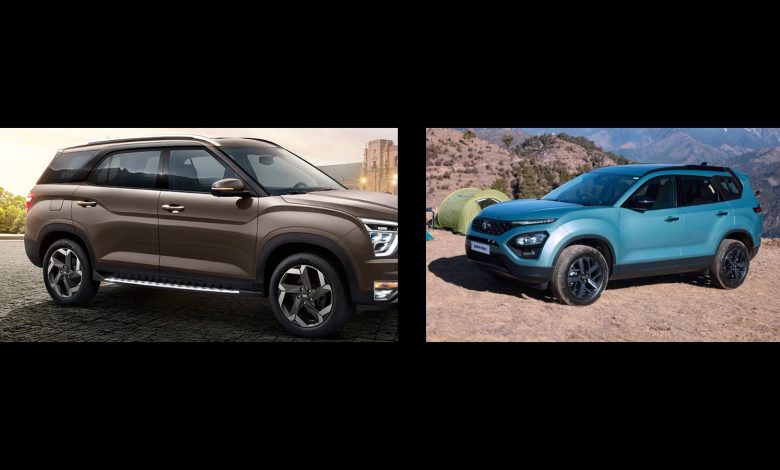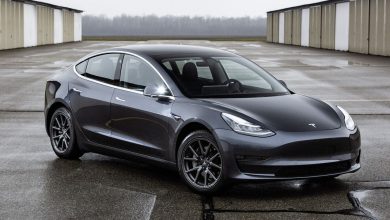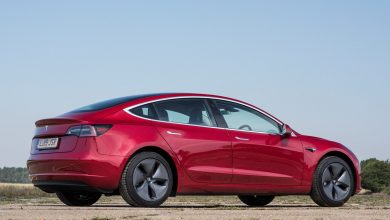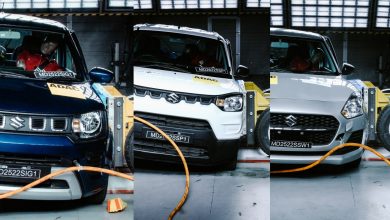
Both the Tata Safari and Hyundai Alcazar need no introduction. These 3 row SUVs are based on their respective compact siblings – the TATA Harrier and the Hyundai Creta. Even though the two are priced close enough, they come with their distinctive set of features to lure customers who are on a hunt for a 7 seater SUV but don’t want to break their bank.
If you’re also someone looking for a family car but are confused between the Safari and Alcazar, this article is just for you. In this piece, we will cover how both of them compare as three-row SUVs and what makes them just so different.
Exterior styling
To begin with, the Hyundai Alcazar and Tata Safari are two very different takes on three-row SUVs. The most obvious difference is in size, the Safari is a full 160 mm longer, 100 mm wider and 110 mm taller than the Alcazar. The numbers may not sound much of a deal-breaker on paper, but Tata’s offering has that “love in first sight” effect on buyers who like big and bold SUVs with high bonnet line and chunkier tires. With an upright tail, the Tata Safari has a road presence that won’t go unnoticed.

On the other hand, the Alcazar might not have the visual mass of the Safari but it is quite sizable in its own right and even boasts of a marginally longer wheelbase.

Overall the Hyundai offering has its own charm, with the only downside in our opinion being the smaller alloys which looks out of place on the beefier Creta sibling. If you are someone who wants their SUV flashy, Alcazar will serve you right with the Hyundai Palisade like large studded grille. Also, the nose actually looks more premium than arguably any other vehicle in the segment. However, Hyundai failed to carry that luxurious styling to the back and sides. They do not look all bad but they won’t win you any praises either. Especially the tail-lights which if you observe closely are almost the same as the Tata Hexa. The irony!
Interiors and features
However, where Hyundai compensates for this lack of luxury is the cabin. From paddle shifters to ventilated front seats, the feature-loaded brown on black dual-tone cabin looks borrowed from a premium segment of cars. Hyundai Alcazar’s cabin, though smaller than its 3-row competition, has a neat and very user-friendly style.


Everything is in clear sight and easy to reach. Hyundai has crafted the Alcazar to please everyone on board. The ventilated front seats are very comfortable and the dash area gets three customizable displays. The main large touchscreen looks really slick and is packed with features including a 360-degree camera which comes really handy in cities. Moreover, the SUV packs in a blind view monitor and the dials in front of the driver are also digital. Other very cool and practical features on the Hyundai SUV is ambient lighting, wireless charging and an onboard air purifier with an AQI display mounted in the centre console.
Even though the Alcazar isn’t all that high of an SUV, it still gets footboards which makes it very easy to enter the car, even for old people. The middle row seats aren’t the widest in the segment but they are well-padded and offer that extra bit of thigh support. The large windows give an open and roomier feel. The rear seats also provide ample legroom and headroom for short people and children.
The Alcazar has nice armrests on the door and the 6 seat version also gets a fixed centre console that doubles as a nice armrest, though it would be more appreciable if it would have been adjustable. This centre console has storage space and also a wireless charging pad just like the front row. Hyundai has also given retractable sunshades, retractable trays with a recess for tablets and mobile phones.
Packed with some of the segment-first and leading features, the Alcazar will be a perfect ride for the younger tech-savvy generation. But if you’re someone who prefers more space over screen and gadgets inside the cabin, Tata Safari will serve you right.
The Tata SUV may not pack as many gadgets and gizmos as its Hyundai rival, but it is nowhere compromising on practicality. The Safari’s cabin looks stylish and really well balanced. The metal works with the wood on the dash and the gloss black plastics on the centre console perfectly suits the Safari’s muscular and bold form factor. The bigger form factor also gives a sense of sitting in a full-grown SUV like the Toyota Fortuner or the Ford Endeavour.

The dash area has an 8.8-inch touchscreen that’s smaller than the one on the tech loaded Alcazar. The screen isn’t the most responsive in the class but comes with a handful of practical features. But the one thing that you would surely wish from the Alcazar to be carried to the Safari, once you drive the former, is the blind view monitor. The thick A-pillar which provides the TATA SUV its strong body form factor, also generally limits the driver’s visibility at crossroads.
Other things that TATA should have given are the front parking sensors complimented by a 360-degree camera. That would have been a welcome feature and definitely would have helped to steer the large form factor of the Safari in the urban traffic. Taller drivers also complain about the dashboard that always stays in contact with the left knee but your body posture will get adjusted with a few days of riding. Especially looking at the dimensions of this ginormous SUV. Simply carrying over the EXACT feature set of the Harrier isn’t really a smart move considering the Safari launched almost an year after the Harrier’s facelift.
Unlike the Alcazar, the Safari’s interior colour theme is very non-flashy or subtle and comes with light upholstery. This could be a pain in cleaning if you often keep your cabin messy. In that case, we suggest you to opt for the dark edition of the safari which comes with an all-black interior.
Where Safari’s cabin shine is the more spacious middle and rear sitting arrangement, thanks to the wider dimension. The cabin feels comfier even with the seven seating arrangements. Just like the Alcazar, it also comes with 6 seat arrangement if you opt for captain seats in the middle row.
The Tata SUV sits notably higher than the Alcazar but like the latter, there’s no footboard to ease the climb in. But the view from the Safari cabin is much better than its Hyundai competitor. TATA has given the SUV what the automaker says, stadium seating, which means the middle row seats are set up slightly higher than the one’s upfront. This allows a great view out for the rear occupants even from the front windscreen.
The Indian automaker has also smartly packed in a boss mode function that allows adjusting front row seats right from the back. In the Safari the seats are also well-padded but the armrest isn’t all that well-positioned. However, the Tata offering does offer ample room for storing small items in the door pockets. But there’s no wireless charging at the back like the Alcazar but the second row gets USB charging slots positioned low down.
Both the Safari and Alcazar pack in a panoramic sunroof, rear disc brakes and the top-spec versions of both models also get six airbags, ESC and Isofix child seat mounts. None of them has been given an NCAP crash rating till now, but given TATA’s track record we expect a full 5 for the Safari while the Alcazar could score maybe a 3 star rating.
Third row comfort and boot
Moving to the last row, the Safari has a clear advantage over the Alcazar. Both the headroom and legroom have ample space to easily adjust someone with a height of 5’10” or maybe even taller if it is for shorter journeys. The windows on the third row are larger than the Alcazar’s and even the vents sit higher up which provides more effective air conditioning.

Another key aspect while considering SUVs is luggage space. While both SUVs miss out on a power tailgate, the Alcazar’s is easier to open and also reveals a larger luggage area with all seats up. Hyundai allows the third-row backrest on its SUV to be folded absolutely flat to create more luggage room.

On the other hand, the Safari’s offers a disappointing luggage room. With all seats up the boot space is only sufficient for a few handbags. The third-row backrests do fold but don’t sit absolutely flush with the floor.
Powertrain and ride quality
Moving to the most important factor, the powertrain. The Safari is available solely with a 2-litre diesel engine that churns out 170hp and 315 Nm of torque. The same one from the Compass and the Harrier. The transmission option includes a 6-speed manual as well as a 6-speed automatic sourced from Hyundai.
Alcazar, on the other hand, comes with more engine choices that include a 2-litre petrol and a 1.5-litre diesel unit. The petrol engine produces a higher power with 159 hp while the diesel unit offers 115 hp and 250 nm. Both powertrains come with manual and automatic gearbox options. One thing to be noted here is the mileage, especially when fuel prices in the country are at an all-time high. The petrol version of Alcazar provides around 14.2 kmpl, while the 1.5 litre diesel seems to be a more efficient option with an impressive return of 18.1 kmpl.
In terms of engine power, none of the Alcazar variants is a match for the Safari. But then, the Hyundai offering is also 400 kgs lighter than the Tata SUV which results in an easier handling and driving experience in cities, especially in traffic. Of course, the blind view monitor, the 360-degree camera, the front sensors and lighter steering also aids the manoeuvring. Overall, the Hyundai Creta engines do not seem to be underpowered in a bigger frame and will serve right in city speeds.
However, things get a little trickier with the bigger bulkier Safari on urban roads. Though the Safari lacks the modern technical aids of the Hyundai Alcazar, the higher seating position definitely gives a good view of the surrounding. Moreover, it gives that proper feel of sitting in a fully grown SUV and that head-turning road presence.
The steering is heavier than the Alcazar’s which makes parking a Safari a real task, but one will get adjusted to it after a few days of ride. However, on that note, a higher resolution reverse camera would have been more appreciated. Apart from the steering, another thing that may take some time to get adjusted to is the acceptable body roll around corners. Overall the Safari is a full rugged SUV package that can be driven in the city or can be taken on the weekend highway rides.
The Safari is marginally quicker than the Alcazar in a 100 kmph sprint and braking is also better on the TATA. Moreover, if you are a fan of louder engine notes, the TATA SUV will sing symphony to your ears. If only Tata had given a 4×4 wheel drive option on the new Safari just like the new one, it would have been an undisputed king of off-road in the segment. Even if it was not 4×4, a RWD version like the Hexa would have also been tremendously better. However, it’s not all bad in this front-wheel driven Safari, as it does a remarkable job by easily gliding over a bad patch of road or roads filled with craters. The ride quality of the Safari being more comfortable. As with usually all Tata cars.
The Alcazar feels like an outsider in these settings and doesn’t give the same confidence as the Safari, even though both of them have almost a similar ground clearance, with the Hyundai’s 200 mm just a shade
less than the TATA’s 205 mm. Both SUVs get traction modes and hill start assist. Safari even has a hill descent control but keep in mind to not go too far off-road in either of them as none of them are made for a pure off-road experience.
To sum things up, though the Tata Safari and the Hyundai Alcazar offers the same seating capacity, both suit a different section of buyers depending on their needs. The Alcazar with its fully tech loaded cabin and modern features will suit customers which are occasionally going to use the third-row seats or use it for luggage with seats down. The lighter, more compact city-friendly body of the Hyundai SUV is a perfect fit for riders who mostly run on traffic-filled roads.
On the other hand, the Safari’s may not come with a state of the art cabin gadgets, but with bigger dimensions, it provides a larger interior space to the passenger, even those sitting in the third row. The more powerful engine and robust body with larger wheels also make the TATA SUV a better option among the two SUVs for highway and mild off-road trips.
The Safari range starts at ₹ 14.99 Lakh (ex-showroom) for the base diesel manual transmission XE model and goes all the way up to ₹ 21.83 Lakh (ex-showroom) for the top-spec XZA Plus Adventure that comes with a diesel engine and an automatic torque converter transmission.
For the Alcazar, the base model comes with a powertrain setup of manual petrol which retails for ₹ 16.30 Lakh (ex-showroom). The top variant Alcazar Signature (O) 6 STR 1.5 Diesel AT Dual Tone comes with a price tag of ₹ 20.15 Lakh (ex-showroom).




